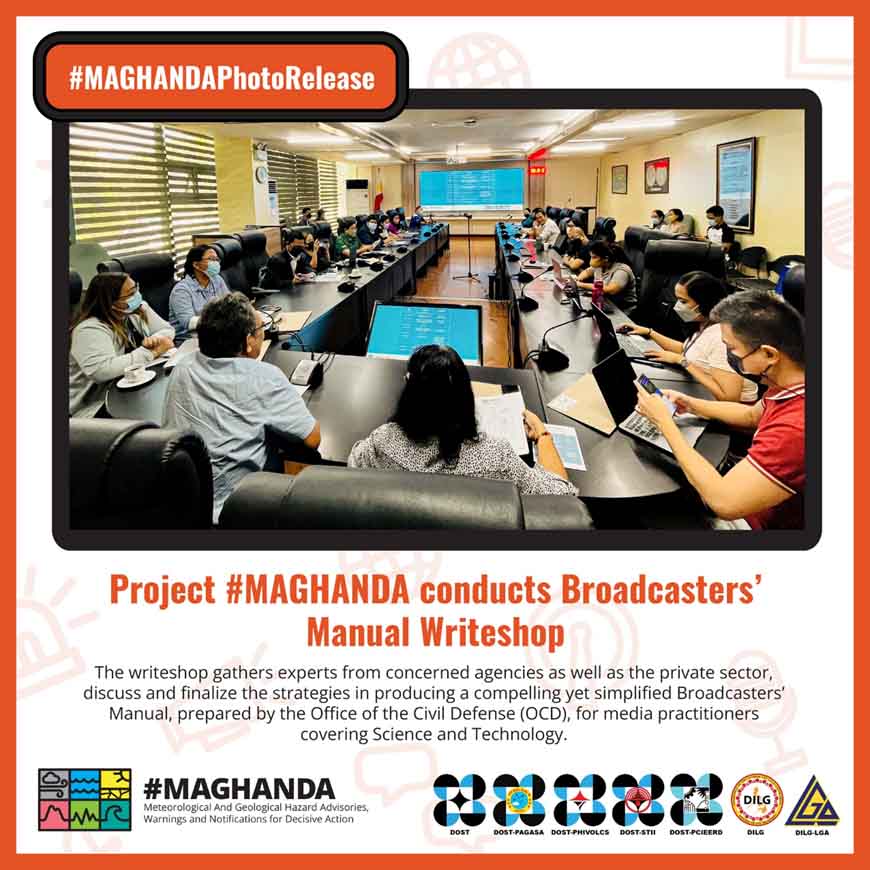In compliance to the Memorandum of Agreement (MOA) between the Department of Science and Technology (DOST) and the Department of Interior and Local Government (DILG) signed last 16 March 2022, Project #MAGHANDA rolled out its learning sessions that started on 4 July 2022, via the zoom platform.
The #MAGHANDA project aims to conduct both asynchronous and synchronous learning sessions for all regions in the country components. The first batches were conducted in Regions XIII, XII, XI, X, IX, VIII, and VII, that include local chief executives (LCEs), disaster risk reduction and management officers (DRRMO), municipal local government operations officers (MLGOOs), information officers from national and local government units, first responders (Philippine National Police, Bureau of Fire Protection, Armed Forces of the Philippines, and the Philippine Coast Guard), and media practitioners.
The DOST’s two warning agencies, the Philippine Atmospheric, Geophysical and Astronomical Services Administration (PAGASA) and the Philippine Institute of Volcanology and Seismology (PHIVOLCS) prepared visually compelling presentations and workshops that covered the following hazards: tropical cyclones, gale warnings, thunderstorms, storm surges, heavy rainfall, flood, ENSO (El Niño and La Niña), volcanoes, earthquakes, and tsunamis.
Several tools and services such as the DOST-PAGASA website and the development of the impact-based Forecasting and Warning System, the GeoRiskPH platform, Rapid Earthquake Damage Assessment System (REDAS), and How Safe is My House, among others, were also explained in full detail by meteorologist and geologist from both aforementioned agencies.
The learning sessions were conducted virtually to educate and develop the skills of the participants in understanding correctly the various warning messages for meteorological and geological hazards and in planning for appropriate disaster response actions.
Aside from the learning sessions that will run until December this year, Project #MAGHANDA conducted a Broadcasters’ Manual Writeshop held at the DOST-PAGASA Amihan Conference Room on 26 August 2022. It aims to update the existing Broadcasters’ Manual prepared by the Office of Civil Defense (OCD) and its partner agencies like the DILG, DOST-PAGASA, DOST-PHIVOLCS, and the Mines and Geosciences Bureau of the Department of Environment and Natural Resources.

The writeshop was participated in by various media practitioners from the Philippine Information Agency (PIA), Kapisanan ng mga Brodkaster ng Pilipinas (KBP), Department of Environment and Natural Resources-Mines and Geosciences Bureau (DENR-MGB), communication consultants, and experts from DOST-PAGASA, DOST-PHIVOLCS, and DOST-Science and Technology Information Institute.
The Broadcaster’s Manual will serve as a guide for media practitioners like news anchors and broadcasters in delivering the news on the weather and other hazards like volcanic eruption, earthquake and tsunami with easy-to-understand information to ensure that the warning messages are clear to the audiences.
In his statement during the writeshop, DOST-PAGASA Administrator Vicente B. Malano, PhD stressed the importance of properly communicating the warning messages and scientific terms for disaster managers and the communities to be prepared to appropriately create and implement effective disaster mitigation plans.
“Tamang kaalaman tungo sa tamang kahandaan. #MAGHANDA para sa ligtas na Pilipinas.” Dr. Malano said.





















